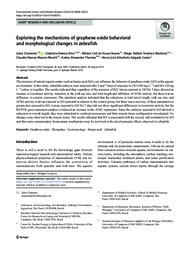Exploring the mechanisms of graphene oxide behavioral and morphological changes in zebrafish.
Exploring the mechanisms of graphene oxide behavioral and morphological changes in zebrafish.
Autoria: CLEMENTE, Z.; SILVA, G. H. da; NUNES, M. C. S.; MARTINEZ, D. S. T.; MAURER-MORELLI, C. V.; THOMAZ, A. A.; CASTRO, V. L. S. S. de
Resumo: Abstract: The presence of natural organic matter such as humic acid (HA) can influence the behavior of graphene oxide (GO) in the aquatic environment. In this study, zebrafish embryos were analyzed after 5 and 7 days of exposure to GO (100 mg L-1) and HA (20 mg L?1) alone or together. The results indicated that, regardless of the presence of HA, larvae exposed to GO for 5 days showed an increase in locomotor activity, reduction in the yolk sac size, and total length and inhibition of AChE activity, but there was no difference in enzyme expression. The statistical analysis indicated that the reductions in total larval length, yolk sac size, and AChE activity in larvae exposed to GO persisted in relation to the control group, but there was a recovery of these parameters in groups also exposed to HA. Larvae exposed to GO for 7 days did not show significant differences in locomotor activity, but the RT-PCR gene expression analysis evidenced an increase in the AChE expression. Since the embryos exposed to GO showed a reduction in overall length, they were submitted to confocal microscopy and their muscle tissue configuration investigated. No changes were observed in the muscle tissue. The results indicated that HA is associated with the toxicity risk modulation by GO and that some compensatory homeostasis mechanisms may be involved in the developmental effects observed in zebrafish.
Ano de publicação: 2019
Tipo de publicação: Artigo de periódico
Unidade: Embrapa Meio Ambiente
Observações
1 - Por padrão são exibidas publicações dos últimos 20 anos. Para encontrar publicações mais antigas, configure o filtro ano de publicação, colocando o ano a partir do qual você deseja encontrar publicações. O filtro está na coluna da esquerda na busca acima.
2 - Para ler algumas publicações da Embrapa (apenas as que estão em formato ePub), é necessário ter, no celular ou computador, um desses softwares gratuitos. Sistemas Android: Google Play Livros; IOS: iBooks; Windows e Linux: software Calibre.
Acesse outras publicações
Acesse a Base de Dados da Pesquisa Agropecuária (BDPA) para consultar o acervo completo das bibliotecas da Embrapa.

